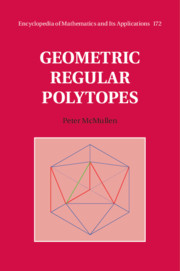7 - Classical Regular Polytopes
from II - Polytopes of Full Rank
Published online by Cambridge University Press: 30 January 2020
Summary
Classical regular polytopes are those whose symmetry groups are generated by hyperplane reflexions; these were the subject of Coxeter’s monograph ‘Regular Polytopes’, which first appeared in 1948. This chapter classifies these polytopes, and describes relationships among them. A new condition is given here to be a classical regular polytope. First treated are the three sequences of polytopes – simplex, staurotope and cube – that occur in all dimensions. The 24-cell is looked at next, introducing the useful role played by quaternions in several places. Next are described the familiar icosahedron and dodecahedron. Then the regular 600-cell is constructed and its realization domain found. The dual 120-cell is then described, followed by finding the regular star-polytopes and their abstract automorphism groups. Then the discrete regular apeirotopes or honeycombs are classified. The regular compounds of polytopes are then described, including some that are relatively new. Throughout, the Petrie polygons of these regular polytopes are found by elementary means, that is, not by solving trigonometric equations. The realization domain of the 120-cell is left until last, because describing it draws on much of the earlier material in the chapter.
Keywords
- Type
- Chapter
- Information
- Geometric Regular Polytopes , pp. 209 - 300Publisher: Cambridge University PressPrint publication year: 2020

